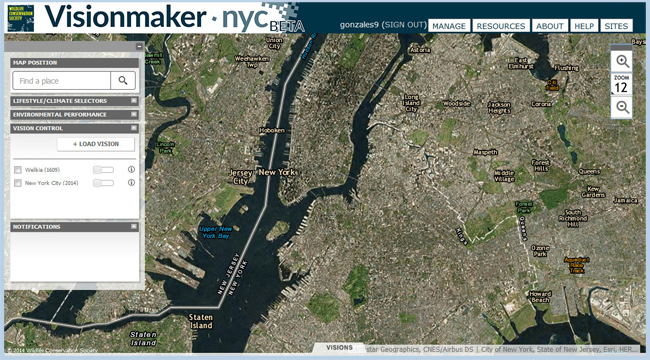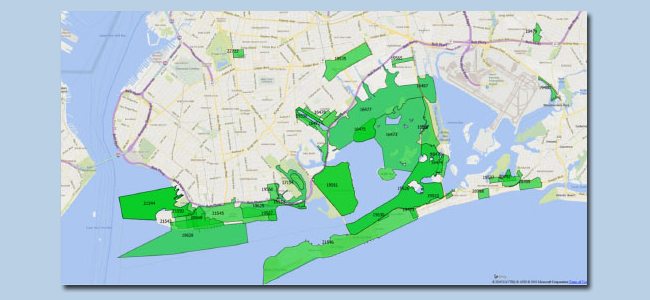
Screen captures from the Visionmaker tool.
— By Chris Gonzales, Communications Specialist, New York Sea Grant
New York, NY, November 13, 2017 - Experts are thinking about “resiliency,” the ability of a community to bounce back from a shock—such as a hurricane or coastal flooding—that New York’s coastal regions may expect with climate change.
Mario Giampieri of the Massachusetts Institute of Technology and his scientific team used an Internet-based tool called Visionmaker to collect ideas from experts and residents about how best to plan for coastal land use—and possible shocks—in New York’s Jamaica Bay. He and his team recently published a paper about their work in the journal Urban Ecosystems.
“We wanted to understand what it would mean for an area to be resilient,” said Katherine Bunting-Howarth, associate director of New York Sea Grant, who worked on the project. “Visionmaker technology brings these ideas to the public, gets people thinking about problem-solving, and does so in a productive manner that takes advantage of democratic participation. People can see how changes in the landscape and their lifestyles can impact the environment.”
With the Visionmaker tool, users create a vision for a specific area, painting different ecosystems on to it. They can change the lifestyle and climate scenarios that inform their visions.

Screen capture from the Visionmaker tool.
The project was funded by the National Park Service. Other partners on the project included New York Sea Grant, Cornell University, and the Wildlife Conservation Society.
Visionmaker was created by the Wildlife Conservation Society to bring technology and ideas about democratic process to land use planning for the Jamaica Bay area watershed. A tidal lagoon on the southeast side of New York City protected by the Rockaway Peninsula, Jamaica Bay is New York City’s largest wetland and open space. Its marshes help to break waves from major storms and absorb carbon dioxide from the atmosphere.
The team held a series of workshops near Jamaica Bay and invited participants from five communities of practice: school teachers, researchers, land managers, officials from environmental not-for-profit organizations, and community board members.
“You can plan to alter the landscape from the current day, or mimic what it must have looked like 100 years ago,” said Bunting-Howarth. “Changes in how we live can impact the environment—from the buildings around us, to streets, trees, and green roofs, to the way we travel to and from work.”
She said that leaders and residents in the community have a voice in planning the coastal region’s future. She hopes to increase public awareness and understanding of coastal resiliency. And thoughtful use of technology could prevent or minimize shocks to the system.
“Visionmaker is freely available online,” she said. “You should try it, too.”
For more, visit visionmaker.us/nyc.
References
Giampiari, m. et al. 2017. Visions of resilience: lessons from applying a digital democracy tool in New York’s Jamaica Bay watershed. Urban Ecosystems. DOI 10.1007/s11252-017-0701-2

Areas of interest selected by Visionmaker workshop participants.
Video Help Series: Understanding the Visionmaker tool
You can view the full series or check out the online tool's help index.
More Info: New York Sea Grant
New York Sea Grant (NYSG), a cooperative program of Cornell University
and the State University of New York, is one of 33 university-based
programs under the National Sea Grant College Program (NSGCP) of the
National Oceanic and Atmospheric Administration (NOAA). The NSGCP
engages this network of the nation’s top universities in conducting
scientific research, education, training and extension projects designed
to foster science-based decisions about the use and conservation of our
aquatic resources. Through its statewide network of integrated
services, NYSG has been promoting coastal vitality, environmental
sustainability, and citizen awareness about the State’s marine and Great
Lakes resources since 1971.
New York Sea Grant maintains Great Lakes offices at SUNY Buffalo, the
Wayne County Cooperative Extension office in Newark and at SUNY Oswego.
In the State's marine waters, NYSG has offices at Stony Brook University
and Stony Brook Manhattan, in the Hudson Valley through Cooperative
Extension in Kingston and at Brooklyn College.
For updates on Sea Grant activities: www.nyseagrant.org has RSS, Facebook, Twitter, and YouTube links. NYSG produces a monthly e-newsletter, "NOAA Sea Grant's Social Media Review," via its blog, www.nyseagrant.org/blog. Our program also offers a free e-list sign up via www.nyseagrant.org/coastlines for its flagship publication, NY Coastlines/Currents, which is published quarterly.